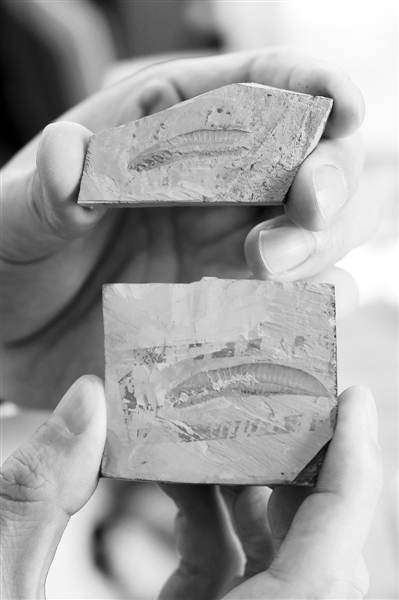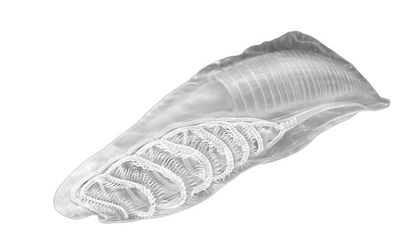The identification of the 500 million-year-old Yunnan worm was written on the first page of vertebrate "genealogy"

Zhao Fangchen, a researcher at Nanjing Institute of Geology and Paleontology, Chinese Academy of Sciences, shows the primitive vertebrate Yunnan insect fossils. Photo courtesy of Xinhua News Agency reporter Luo Boshe/vision china

Yang Dinghua Drawing of Ecological Restoration Map of Yunnan Insects
The research team analyzed the branchial arch structure of 127 specimens of Yunnan worms produced in Haikou area, and found the three-dimensional preserved laminated disk cell structure and protein microfibril structure in the pharyngeal arch of Yunnan worms for the first time. This proves that Yunnan worm has a unique pharyngeal arch composed of cellular cartilage in vertebrates and belongs to primitive vertebrates.
Where did modern vertebrates come from? What does the oldest vertebrate look like? These major scientific problems have always attracted paleontologists to explore.
Chengjiang Fauna, located in Yunnan, China, has preserved a large number of ancestral groups of vertebrates.
Previously, it was generally believed that the oldest vertebrate was Kunming fish from Chengjiang fauna, and it was speculated that the ancestors of vertebrates were a kind of retrognathus with notochord, dorsal neural tube and branchial fissure. However, this hypothesis has never been supported by fossil evidence.
Today, this mystery has finally been solved.
On July 8th, Science, an international authoritative academic journal, published "The Earth — The research results of the team "Early Evolution of Life System" confirmed that Yunnan worm in Chengjiang fauna in China was the most primitive group of vertebrates 518 million years ago.
The definition of Yunnan insect identity was once controversial.
The Burgess shale fauna in Canada about 505 million years ago and the Chengjiang fauna in China about 518 million years ago are rich and beautifully preserved animal fossils characterized by soft body structure.
Among them, Burgess shale fauna discovered in 1909 produced cephalochordate pickup fish and vertebrate post-Sprigg fish fossils, while scientists found many chordate fossils in Chengjiang fauna, including vertebrate Kunming fish and Yunnan worm with doubtful taxonomic position. These fossils are the oldest chordates in the world so far, providing valuable materials for uncovering the mystery of the origin and early evolution of vertebrates.
From the morphological point of view, Yunnan worms are somewhat similar to the current worms. Their bodies are flat on their sides, generally only 3 cm to 4 cm long.
"Different from Kunming fish with typical vertebrate characteristics, Yunnan insect is more similar to amphioxus, but its position in the origin of vertebrates and the phylogenetic tree of metazoa has always been controversial. Jiang Baoyu, the co-author of the paper and a professor at Nanjing University, introduced it.
In 1995, Nature published a study on Yunnan worm as the earliest chordate. The New York Times and Science Weekly also made special comments on it.
After that, China scholar Chen Junyuan and others found a large number of new specimens of Yunnan worms in Haikou, Kunming. Based on the finer anatomical structure of these specimens, they classified Yunnan worms as primitive cephalopods and thought that their evolutionary position was between amphioxus and lamprey, a vertebrate. After this achievement was published in Nature in 1999, there was a great discussion about the taxonomic position of Yunnan insects in academic circles.
"Because different scholars have different explanations on the details of different soft tissues preserved by Yunnan worms, Yunnan worms have been classified into vertebrates, cephalochordates, hemichordates, faunas and even primitive bilaterally symmetrical animals since they were first reported in 1991." Jiang Baoyu introduced that the controversy over the taxonomic position of Yunnan insects has seriously affected the research on the origin of vertebrates based on such key fossils.
The special characteristics of pharyngeal arch help it to verify its true identity
In view of the mystery of the taxonomic position of Yunnan insects, the research team used various modern experimental techniques such as three-dimensional X-ray scanning microscope, Fourier infrared spectrum, Raman spectrum, scanning electron microscope and transmission electron microscope to study, hoping to solve this puzzle from the microscopic anatomical structure.
Based on the important clue put forward by Chen Junyuan and other scholars in 2003 that the branchial arch of Yunnan worms may have cytocartilage, the research team analyzed the branchial arch structure of 127 specimens of Yunnan worms produced in Haikou area, and found the laminated disk-like cell structure and protein microfibril structure preserved in three dimensions in Yunnan worms’ pharyngeal arch for the first time.
"The discoid cell structure is a unique arrangement of chondrocytes, and protein microfibril is the fiber structure of the common intercellular matrix of vertebrate cartilage. These two characteristics prove that Yunnan worm has a unique pharyngeal arch composed of cytocartilage in vertebrates, indicating that Yunnan worm belongs to primitive vertebrates. " Jiang Baoyu said.
In order to further determine the specific evolutionary position of Yunnan insects, the research team integrated the latest character matrix including the fossils of the faunas and early vertebrates, and added the newly observed characters of Yunnan insects, and used Bayesian algorithm for reconstruction calculation. The analysis results support that Yunnan worm is in the most basic position of vertebrate pedigree, which is between caudate and other vertebrates.
"The origin of vertebrate jaws has also puzzled the academic community for a long time. At the beginning of the 19th century, some scientists put forward the idea that in the long evolution, the branchial arch evolved into the jaw arch and the tongue arch, but no fossil record was found to support it. " Jiang Baoyu introduced that the subsequent scientific discovery made people question this hypothesis.
"The genes controlling the first two branchial arches of the living jawless vertebrates, the blind eel and the lamprey, did not develop into the jaw arch and the tongue arch, but developed into the upper and lower lips, and no trace of the branchial arch was seen during the development, which is different from the branchial arch of the jawed vertebrates." Jiang Baoyu said that in this study, after confirming the "identity" of Yunnan worm, the researchers found the same laminated cell structure, gill filaments and protein microfibrils as other branchial arches in the back at the position equivalent to the first pair of pharyngeal arches.
Therefore, Yunnan worm has seven pairs of pharyngeal arches which are similar to each other from front to back and also have cytocartilage. Similar pharyngeal arches also appeared in another Cambrian backbone vertebrate — — After Sprigg fish.
"The discovery of seven pairs of similar pharyngeal arches of Yunnan insects supports the hypothesis of homology of vertebrate pharyngeal arches put forward by anatomists as early as the 19th century, that is, the gill arch of fish is the prototype of jaw arch and tongue arch, and the jaw arch and tongue arch of vertebrate are a series of homologous structures." Jiang Baoyu said that this means that although the pharyngeal arches in different positions of living vertebrates will develop into bones with different shapes such as jaw arch, tongue arch and gill arch, the pharyngeal arches in different positions in the early stage of vertebrate evolution are similar to each other.
Basilar pharyngeal cranium confirms the morphology of vertebrate ancestors’ pharyngeal cranium
Jiang Baoyu believes that another important new discovery of this study is that seven pairs of pharyngeal arches of Yunnan worm are connected by paired horizontal cartilage at both ends of the ventral back, forming a basket-like pharyngeal skull. Pharyngeal cranium refers to a group of bone fragments around the digestive tract of vertebrate head, which plays a supporting and protecting role. The pharyngeal cranium of living vertebrates is composed of the bones of pharyngeal arch such as jaw arch, tongue arch and branchial arch.
"Basket-shaped pharyngeal cranium is a typical feature of modern jaw-less vertebrates and fossil jaw-less fish. However, after Cambrian, the pharyngeal cranium of Sprigg fish and jaw-less vertebrates consists of a series of cartilage rods separated from each other." Jiang Baoyu said that this feature of the post-Sprigg fish caused controversy about the morphology of the pharynx and cranium of vertebrate ancestors. The early appearance of the pharyngeal cranium features of Yunnan insects located in the most basic position of vertebrates supports the view that the basket-shaped pharyngeal cranium is an older ancestral feature.
It can be seen that as the oldest close relative of living vertebrates, Yunnan worm provides key evidence for revealing the origin and early evolution of vertebrates, and will have a far-reaching impact on the exploration of the evolution of vertebrates’ jaws and other key features.
Jiang Baoyu believes that "from another perspective, this study once again shows that Chengjiang fauna fossils have the potential to preserve micro-nano scale fine biological structures."
This achievement has also been highly praised by the reviewers of Science magazine: "This is a great contribution to science, and this paper will become a key paper in vertebrate paleontology, showing the long-awaited and most credible evidence of anatomical structure fossils and solving the controversy of vertebrates in Cambrian. The information they show is a milestone, and even higher-resolution research will be difficult to surpass in many years to come. "